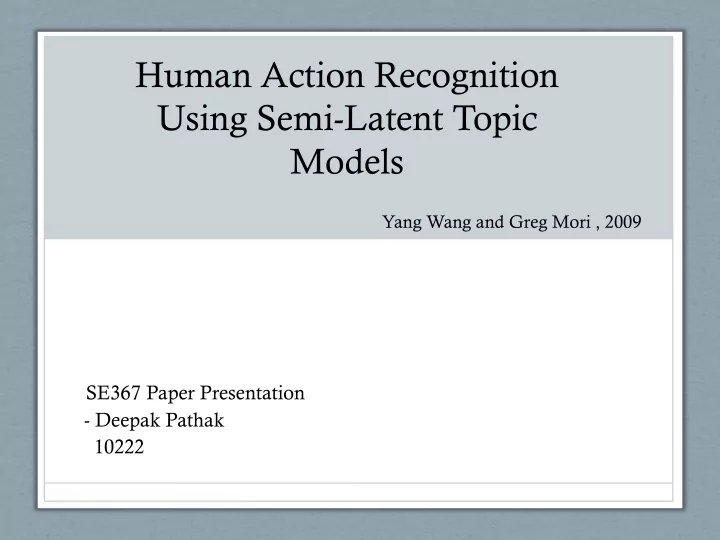

Human Action Recognition Using Semi-Latent Topic Models Yang Wang and Greg Mori , 2009 SE367 Paper Presentation - Deepak Pathak 10222
Introduction • Human Action Recognition ( What ?) • Still Images (eg: Poselets) v/s Video Sequences Motivation: • Bag of words representation of image – good results in Object Recognition [Wang,Mori,2009] Bag of Words
Earlier Work (Action Recognition) • Motion Based: • Interest Point Methods: Learning features which Capture local features e.g. based on visual cues train SVM over the (motion + shape) , optical features obtained by STIP flows • Temporal Dynamic Models: • Topic Models: Generative (e.g. HMM) and “Bag of Words” Discriminative (e.g. CRF) Paradigm. to model and learn features (analogous to NLP)
Bag of Words (analogue: NLP to VISION) CodeWord Word (Each frame) CodeBook Vocabulary (all codewords) Topic Action Label Video Sequence Document
Construction of CodeBook Similarity measure Compute Optical Track and between different Flow – then Stabilize person frames descriptors Affinity Matrix K-medoid Codewords: (among all frames clustering into V centroid of these cluster of all sequences) clusters * Here codeword capture large scale features (containing overall temporal information of all videos in training set) * Each video is a sequence of frames where each frame is represented by any codeword obtained above, thus video is a bag of words, removing temporal information.
Topic Models • LDA : Genereative • Semilatent LDA: model to learn the Introduces supervision in distribution of LDA by making use of topics(actions) given a action labels present in document(video) and training dataset. distribution of topics - Thus, better estimate the (action) over words parameters of probability (codewords). Proposed distribution - Dirichlet Distribution Modification • Semilatent CTM- CTM : Similar but Supervised CTM • Logistic Distribution to properly correlation of Note: Don’t have to different topics in a choose topics as they are document. just equal to class labels (unlike unsupervised)
Classification • Classify each frame in the sequence: For each frame, given frame calculate its distribution over action labels i.e. p(z i | W ) . Here, we chose W instead of just the corresponding frame so as to ensure that action label not just depend on the frame itself but video sequence as a whole • SLDA : Models/approximates this probability distribution using other distribution by minimizing KL divergence between the two. • SCTM : It approximates by using coordinate ascent techniques (Variational EM-expected maximization) Firstly we can classify each frame using distribution over • action labels(take maximum) and then if video contains single action then perform majority voting.
Results (per video classification) • Soccer Dataset: • KTH Dataset: SCTM - 78.64% SLDA - 91.2% SLDA - 77.81% SCTM - 90.33% Ballet Dataset: • Weizmann Dataset: • SCTM - 91.36% SLDA - 100% SLDA - 88.66% SCTM - 100% CTM captures correlations • Hockey Dataset: better than LDA, thus SLDA - 87.5% performs better on multiple SCTM - 76.04% action video datasets (i.e. soccer & ballet).
Datasets [Wang,Mori,2009] Sample frames from our datasets
Conclusion Proposals : • 1. A novel “Bag of words” approach for representing video sequences where each frame corresponds to a word, thus capturing large scale features. 2. Two new models : SLDA & SCTM which are basically supervised form of LDA &CTM, thus training is easy with better performance. • Benefit : This paper focuses mainly on per-frame classification, thus works significantly well on datasets of video containing multiple actions.
References Wang, Yang, and Greg Mori. "Human action recognition • by semilatent topic models." Pattern Analysis and Machine Intelligence, IEEE Transactions on 31.10 (2009): 1762-1774. Blei, David M., Andrew Y . Ng, and Michael I. Jordan. • "Latent dirichlet allocation." the Journal of machine Learning research 3 (2003): 993-1022. • Lucas, Bruce D., and Takeo Kanade. "An iterative image registration technique with an application to stereo vision." Proceedings of the 7th international joint conference on Artificial intelligence . 1981.
Recommend
More recommend